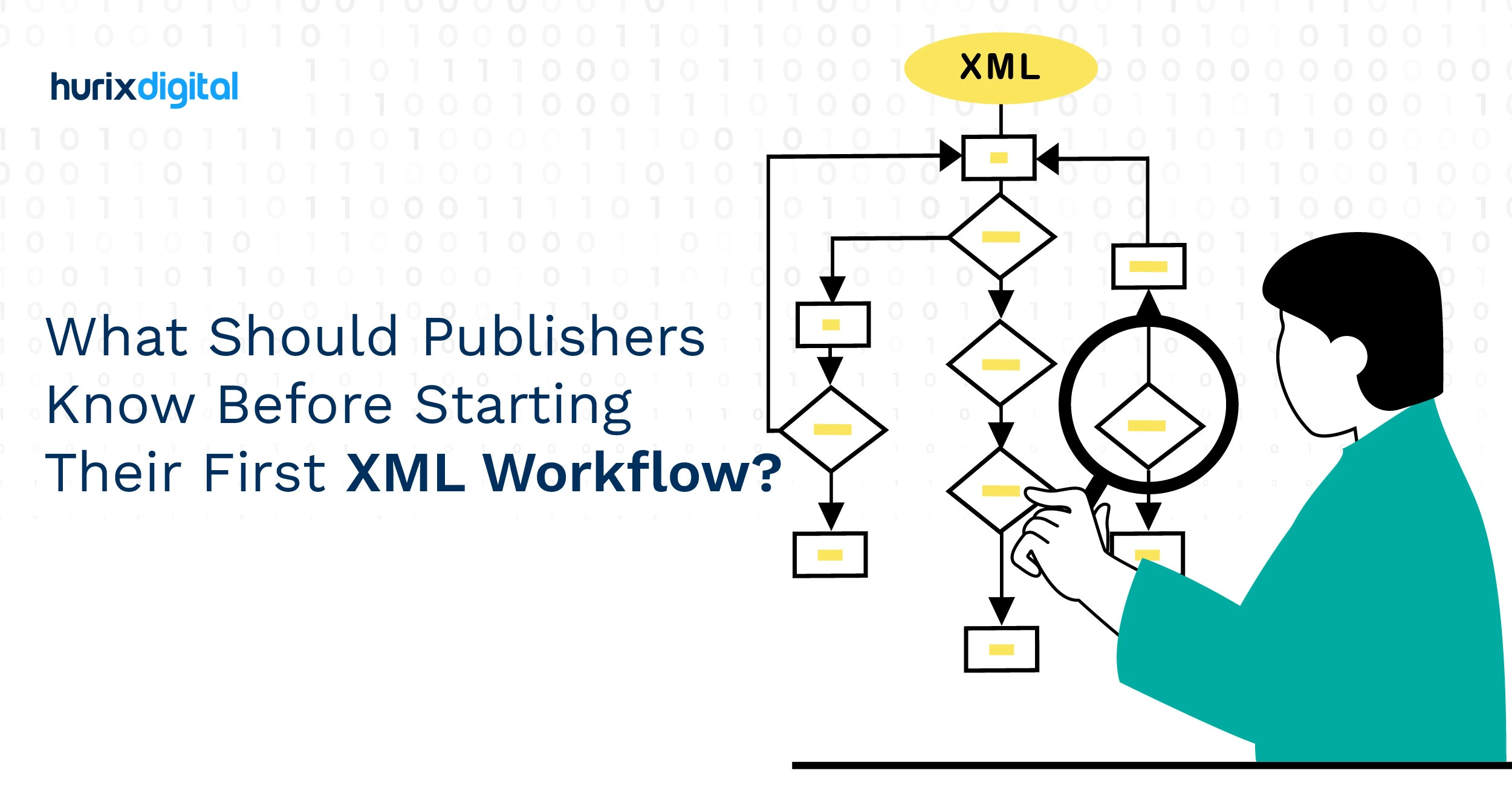
What Should Publishers Know Before Starting Their First XML Workflow?
Summarize with:
In the rapidly evolving world of journal publishing, efficient and streamlined workflows are essential for maintaining high-quality content delivery. One critical component of modern publishing is the use of XML (Extensible Markup Language) to structure and manage content. XML workflows facilitate seamless collaboration, enhance data consistency, and improve content accessibility across multiple platforms.
Whether new to XML or looking to optimize your journal publishing processes, understanding and implementing an XML workflow can significantly improve productivity and reduce errors. This comprehensive guide will walk you through everything you need to know about XML workflows in journal publishing.
Table of Contents:
- What is XML and Why Does it Matter?
- Key Stages of an XML Workflow in Journal Publishing
- The Evolution of Journal Publishing
- Understanding XML-First Workflow
- Traditional Publishing vs. XML Workflow: A Game-Changer for Efficiency
- The Significance of Using XML in Publishing
- Role of XML Publishing Software in Print and Digital Publishing
- Breaking Ground with Your First XML Workflow
- Best Practices for Journal XML Workflows
- A Final Word
What is XML and Why Does it Matter?
Extensible Markup Language, or XML, is the new standard in digital publishing. An XML workflow is extensible as it allows you to define your own tags in the order they occur and the way they should be processed or displayed. Markup allows you to define each element in the XML as a tag or a set of tags. XML is also a meta-language, similar to HTML but much more flexible.
Publishers generally receive manuscripts in Word file format from authors, subject matter experts, and other contributors. They then have to typeset on publishing software such as InDesign to create interactive PDF files as end deliverables. This traditional workflow, however, is not dynamic in nature. XML offers a better approach by providing a markup language that serves as an ideal publishing process in any digital publishing environment.
What Makes XML Special?
XML is a preferred format in print and digital publishing due to its interoperability between platforms and universal standards. It helps create an ideal environment for sharing and editing content. Since it separates content from its formatting, content can be edited and re-formatted simultaneously, thus allowing for seamless integration between the beginning and production phases within a publication’s life cycle.
An XML workflow is extensible as it allows you to define your own tags in the order they occur and the way they should be processed or displayed. Markup allows you to define each element in the XML as a tag or a set of tags. This flexibility removes all limitations of size and layout and can convert all types of document formats into information-ready files, which can be displayed and interpreted on all device types.
Key Stages of an XML Workflow in Journal Publishing
XML workflows involve processes designed to manage content from creation to delivery efficiently. Understanding the typical stages of an XML workflow helps ensure consistency and accuracy throughout the journal publishing process. Below is an outline of each major step in a standard XML workflow:

1. XML Document Creation
The workflow begins with creating an XML document using an XML editor or authoring tool. The document is structured using XML tags, which define the elements and their relationships within it. This is where the XML-first approach begins—tags are inserted from the very beginning rather than as an afterthought.
2. XML Document Validation
Once the XML document is created, it may need to be validated against a specific XML schema or Document Type Definition (DTD). This step ensures the document adheres to the defined structure, data types, and constraints. Validation is crucial for maintaining consistency across all published content.
Indicators of a strictly compliant system include:
- Information is originally authored in XML
- All XML capabilities, including advanced constructs, are completely supported
- XML is the default file format
3. XML Document Editing
XML documents often require modifications or updates. The workflow includes editing an XML document by inserting, deleting, or updating elements, attributes, and values. This is achievable using both manual and automated processes, providing flexibility for publishers to make changes efficiently.
4. XML Document Transformation
XML documents can be transformed from one format to another using technologies like XSLT (Extensible Stylesheet Language Transformations). Transformation allows you to extract, restructure, or present data from an XML document in other formats, such as HTML, PDF, or any other XML schema. This capability is what makes XML so powerful for multi-format publishing.
5. XML Document Parsing and Processing
Software applications must parse and process XML documents in many workflows. This entails extracting information from the XML document, performing calculations or operations, and generating outputs or performing specific actions based on the data contained within the XML.
6. XML Document Integration
XML is commonly used for data interchange between different systems or applications. Integration involves sending or receiving XML documents between various software components or systems, enabling seamless collaboration across different platforms and tools.
The Evolution of Journal Publishing
To truly appreciate the transformative power of XML workflows, it’s essential to understand the evolution of journal publishing itself.
Early Journals
The first academic journals emerged in the 17th century, with publications like the “Journal des Sçavans” and the “Philosophical Transactions of the Royal Society” pioneering scholarly communication. These early journals were printed on paper and distributed physically.
18th and 19th Centuries
During this period, the number of academic journals grew significantly. Journals became more specialized, focusing on specific fields of study. The peer review process became more formalized, establishing standards for academic publishing that persist today.
Rise of Commercial Publishing
The 20th century saw the rise of commercial publishers who took over the production and distribution of many academic journals. This period brought increased professionalization but also rising costs and accessibility challenges.
Digital Publishing
The late 20th and early 21st centuries witnessed the transition from print to digital publishing. Online journals became common, offering advantages such as faster publication times, broader accessibility, and multimedia integration. This is where XML began to play a crucial role.
Open Access
The open access movement gained momentum in the 2000s, advocating for unrestricted access to scholarly research. Many journals adopted open access models, making research more widely available and democratizing knowledge.
Future of Journal Publishing
Technologies continuously developing are just the tip of the iceberg. Funding models will change, and reader expectations will define journal publishing in the future. Some of the trends that will define journal publishing in the future include open science, machine learning, AI, and the increasing emphasis on data in academic research, among many others.
Understanding XML-First Workflow
The XML-first approach represents a fundamental shift in how publishers handle content. Understanding the difference between traditional and XML-first workflows is crucial for modern publishers.
Traditional Workflow
In a traditional workflow, content is first created and edited in word processing software. The entire document is then converted to PDF as it moves through different channels, and XML tags are added only at the end—if at all. This approach creates several limitations:
- Content is locked into specific formats
- Making changes requires reformatting
- Multi-platform delivery is cumbersome
- Content reuse is difficult
XML-First Workflow
In contrast, with an XML-first workflow, XML tags are inserted from the beginning, and documents are formulated with XML in a retrospective effect from the start. XML severs the ties between content and layout, thus separating content from format.
This separation makes the content:
- Secure: Protected from format-related corruption
- Editable: Easy to modify without reformatting
- Convertible: Ready to transform into multiple output formats
- Reusable: Simple to repurpose across different publications
The XML-first approach is now common with publishers who use it to produce any form of digital content. This new style of publishing is based on the size and layout-agnostic principle, meaning content isn’t tied to any particular display format or device.
Traditional Publishing vs. XML Workflow: A Game-Changer for Efficiency
The contrast between traditional publishing and XML workflows reveals why forward-thinking publishers are making the transition.
Traditional Publishing Limitations:
- Format dependency: Content locked into specific layouts
- Redundancy: Multiple versions must be maintained separately
- Editing challenges: Changes require reformatting across all versions
- Limited reusability: Difficult to repurpose content
- Device constraints: Not optimized for multiple platforms
XML Workflow Advantages:
- Single source: One XML file generates all formats
- Dynamic formatting: Automatic adaptation to different outputs
- Efficient editing: Changes propagate across all formats
- Maximum reusability: Content easily repurposed
- Universal compatibility: Works across all devices and platforms
With XML, publishers can simplify the publishing process and deliver content in multiple formats such as PDF, HTML, ePapers, eMagazines, and ePub. Since XML breaks the ties between content and format, publishers can also repurpose layouts and content across various platforms such as QuarkXPress and InDesign.
The Significance of Using XML in Publishing
XML offers five fundamental characteristics that make it indispensable for modern publishing:
1. Platform-Independent
XML is platform-independent, meaning it can be used on any system regardless of the operating system, programming language, or software application. Platform-independent XML documents can be exchanged and processed across different hardware and software platforms without modification.
This is achieved by adhering to standards and best practices for XML development, such as:
- Using a consistent and well-defined document structure
- Avoiding platform-specific coding practices or extensions
- Defining XML schemas and DTDs that are themselves platform-independent
Platform-independent XML is particularly useful for data interchange between different software applications or systems that run on different platforms or use different programming languages.
2. Self-Describing
XML is a self-describing language, meaning it provides a clear and easy-to-understand description of the data it contains. A self-describing XML document is designed to be easily understood by humans and software applications alike, without relying on any additional information beyond the XML document itself.
This is achieved by using well-defined XML tags and attributes that provide meaningful descriptions of the data elements they represent, along with a consistent document structure. This makes it easy for different systems to understand and interpret the data without external documentation.
3. Extensible
XML is extensible, meaning it allows developers to create their own tags and elements, making it suitable for a wide range of applications. Unlike rigid formats, XML can be customized to meet specific publishing requirements, whether for scientific journals, literary magazines, or technical documentation.
4. Human-Readable
XML is human-readable, meaning it can be easily read and understood by humans. This makes it easy for developers and editors to create, modify, and debug XML files without specialized tools. While XML editors enhance productivity, the underlying code remains accessible and understandable.
5. Interoperable
XML is interoperable, meaning it can be used to exchange data between different systems and applications, even if they are developed by different vendors or on different platforms. This interoperability is crucial in today’s publishing ecosystem, where content must flow seamlessly between authoring tools, content management systems, typesetting software, and distribution platforms.
Overall, the significance of using XML lies in its ability to provide a standardized, flexible, and interoperable format for storing and exchanging data between different software systems.
Role of XML Publishing Software in Print and Digital Publishing
Publishing print or digital content is a lengthy and cumbersome process that requires publishers to create several formats of documents and maintain them. Further, editing all these formats is another challenge that often means dealing with redundancy. However, using an XML workflow allows you to accomplish this much more simply and conveniently.
Advantages of XML-Based Publishing
A publishing process based on XML (print or digital) offers several significant advantages:
- Platform and software independence: Content defined in XML publishing software works across all systems
- Format independence: Since XML separates published content from presentational information, it’s independent of any particular display format
- Future-proof: As new formats and platforms emerge, XML content can be easily adapted
- Consistency: Automated formatting ensures visual consistency across all outputs
- Efficiency: Single-source publishing dramatically reduces production time and costs
Breaking Ground with Your First XML Workflow
Implementing your first XML workflow might seem daunting, but breaking it down into manageable steps makes the process straightforward.
Step 1: Assess Your Current Workflow
Before implementing XML, thoroughly document your existing publishing process:
- Identify all content formats you currently produce
- Map out the content creation and editing process
- Document all stakeholders involved
- Identify pain points and inefficiencies
- Determine your multi-format publishing needs
Step 2: Define Your XML Schema
Your XML schema defines the structure of your content. For journal publishing, consider:
- Article metadata (title, authors, affiliations, dates)
- Structural elements (sections, paragraphs, lists)
- Special elements (figures, tables, equations, citations)
- Formatting requirements (emphasis, links, footnotes)
You can adopt existing schemas like JATS (Journal Article Tag Suite) or create custom schemas tailored to your specific needs.
Step 3: Select Appropriate Tools
Choose XML authoring and processing tools that fit your workflow:
- XML Editors: oXygen XML Editor, XMLmind, or Arbortext
- Transformation Tools: XSLT processors for format conversion
- Validation Tools: Schema validators to ensure compliance
- Publishing Platforms: Systems that support XML-first workflows
Step 4: Train Your Team
Successful XML implementation requires team buy-in:
- Provide comprehensive training on XML concepts
- Offer hands-on practice with selected tools
- Create documentation and quick reference guides
- Establish support channels for questions
- Start with a pilot project before full rollout
Step 5: Implement Gradually
Don’t try to convert everything at once:
- Begin with new content rather than converting legacy materials
- Start with a single publication or content type
- Refine your process based on initial experiences
- Gradually expand to other publications
- Eventually, consider converting high-value legacy content
Best Practices for Journal XML Workflows
Apply these strategies to build a robust and efficient XML publishing workflow:
- Adopt Standard Schemas: Use established schemas like JATS rather than creating custom ones
- Automate Where Possible: Leverage automation for repetitive tasks
- Maintain Clean XML: Keep XML well-formed and properly validated
- Document Your Process: Create clear documentation for all workflow steps
- Version Control: Implement robust version control systems
- Backup Regularly: Maintain secure backups of XML files
- Plan for Exceptions: Have processes for handling non-standard content
- Continuous Improvement: Regularly review and refine your workflow
A Final Word
XML workflows represent a fundamental transformation in journal publishing, offering unprecedented efficiency, flexibility, and quality. By separating content from presentation, XML enables publishers to create once and publish everywhere—dramatically reducing costs while improving output quality.
Whether you’re publishing academic journals, technical documentation, or any other structured content, implementing an XML workflow will transform your publishing operations. Start with a clear understanding of your requirements, choose appropriate tools and standards, train your team thoroughly, and implement gradually.
The future of publishing is XML-based, and the time to begin your transition is now. By following the guidance in this comprehensive guide, you can successfully implement your first XML workflow and position your publishing operation for long-term success in the digital age.
Ready to transform your journal publishing workflow? Contact Hurix Digital to learn how our XML conversion and publishing solutions can help you achieve greater efficiency, reduce costs, and deliver higher-quality content across all platforms.
Summarize with:

Vice President – Content Transformation at HurixDigital, based in Chennai. With nearly 20 years in digital content, he leads large-scale transformation and accessibility initiatives. A frequent presenter (e.g., London Book Fair 2025), Gokulnath drives AI-powered publishing solutions and inclusive content strategies for global clients
 Upcoming Masterclass | Build an Army of Brand Evangelists using Training & Development | November 20th, 8:30 AM PDT | 11:30 AM EDT | 10:00 PM IST
Upcoming Masterclass | Build an Army of Brand Evangelists using Training & Development | November 20th, 8:30 AM PDT | 11:30 AM EDT | 10:00 PM IST
